Karen Margulis gives great advice for when you’re traveling and don’t have time to paint. She says that if the destination allows it, make sure there are plenty of public art opportunities available so your creativity doesn’t go stagnant while on location!
It was the bucket-list trip of a lifetime. When a friend invited me to join her small group on a trip to the Provence region in France during the lavender bloom, I jumped at the chance. There was a catch, however— it wasn’t a painting trip. Only two of us in our group of five were artists, and our wish lists were quite varied. I was the only one, for example, who dreamed of painting in the lavender fields. It turns out I need not have worried—I actually managed to squeeze lots of painting time into my non-art-specific adventure. In fact, traveling like this was a surprisingly productive way to experience the region. I returned home full of inspiration, and with a portfolio full of paintings. I painted 40 small studies and took over 3,000 photos—more than enough for years of paintings.
I was able to make this happen, in large part, because of the way my travel companions and I structured our days—exploring the area early in the morning and late in the day. This gave me quiet time at midday to paint. I painted my studies on 5×7 papers using my Heilman single sketchbox and the photos I’d taken. Working from photos rather than on site provided the freedom to spend more time exploring the area and gathering inspiration and reference. I made sure to paint my studies while the inspiration from each outing was still fresh in my mind. Those studies have inspired many more paintings.
Packing Supplies for Painting on Vacation
I always want to have art supplies on a trip so I put together a small kit that fits into my backpack. I don’t use a tripod or easel. Instead I attach my paper to a piece of foam core and hold it in my lap or lay it flat. I like to use the Heilman single sketchbox with an array of pastels.
I also bring an assortment of my favorite sanded pastel papers—UART, Pastel Premier and Pastelmat. It’s important to bring paper that‘s familiar to you. Unless you have a lot of time to experiment, it’s safer to work on paper you know. I cut full sheets of paper into smaller sizes—mostly 5×7 and some 8×10. Sometimes I’ll tone a few sheets of paper beforehand in my favorite plein air color (a medium-value gray).
I fill my Itoya plastic portfolio folders with the cut paper. The folders have plastic sleeves that work great for keeping paper protected during transport. My finished paintings go back into the plastic sleeve of the folder as well. Sometimes a little residual pastel dust is left behind on the plastic, but not enough to harm the painting. The folders fit easily into my backpack, which makes them perfect for keeping both paper and paintings safe while traveling.
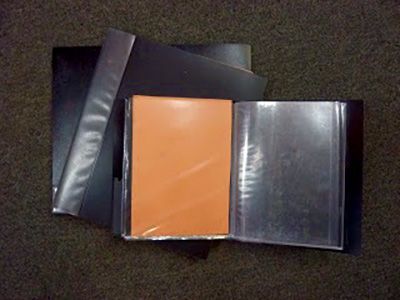
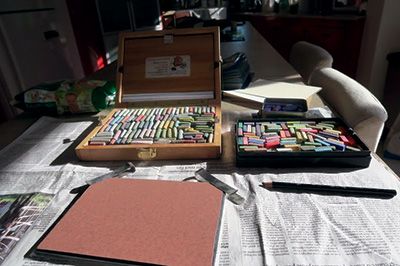
“Working from photos rather than on site gave me the freedom to spend more time gathering inspiration and reference while exploring the area.”
Karen Margolis
9 Ways to Make the Most of Your Time
- Plan your trip for the right time of year. We did a lot of research before our trip and determined that the best time to see lavender in bloom in Provence would be during the first two weeks of July.
- Choose a home base and rent a car. Having a car will expand your range if you wish to explore the nooks and crannies beyond the well-known tourist spots. We rented a home for 10 days in the small village of Goult. It was authentic and not overrun by tourists, yet still close to many of the more well-known villages and attractions in the region. Some of our best days were spent exploring our little village.
- Plan the timing of your outings carefully. It was hot during our stay in Provence, so we chose to explore in the early morning and late after-noons. Not only was the temperature more comfortable at those times, it was easier to find parking in the more crowded tourist spots. This is also when you’ll find the most interesting light for taking photos or for plein air painting.
- Choose your outings wisely. The region we visited is big and offers so much to explore. We knew that we couldn’t possibly see it all in just a week or two, so we selected a must-see item from everyone’s list. It’s also important to alternate touring days with rest days. Hanging around the village with the locals was a highlight of the trip. The downtime days gave everyone a chance to recharge. They were also the days I painted the most.
- Visit the same scene at different times of day. We spent one long day touring on the lavender route. We began with a very early stop at the iconic Abbaye de Senanaque. The lavender route was amazing but I took my best photos in a field not far from our home base. We made several visits at various times of day. Each time the change in lighting made it look like a brand new spot.
- Take the side roads. Don’t be afraid to venture off the beaten path to explore the countryside. This is where you’ll make those memorable discoveries like a field of sunflowers or a windmill in the middle of a lavender field. We had a paper map and GPS and quickly became proficient at understanding directions in French.
- Don’t miss the markets. The markets of Provence were a definite highlight. Each village has their own market day so we made sure to visit as many as we could. Each one had a different flavor but all of them were filled with inspiration for future paintings! Plan to go to the markets when they first open. Not only will you get the best light and photos, you’ll avoid the heat of the day. The market is the perfect place to pick up makings for a picnic lunch.
- Be a local and not a tourist. We were tourists, of course, but we made an effort to experience the area like a local and not just hit the tourist attractions. Our first night we went to the village festival and shared a meal of delicious soup and wine with the local villagers. We stood in line every day with the locals at the village patisserie to get our daily baguettes and other goodies. We attempted to speak French even though most people we met understood English. We found most enjoyed our attempts to speak the language.
- Bring art supplies but plan to travel light. Even though this was not a painting trip, I knew I needed to have some supplies with me to take advantage of any opportunities I might have. My travel companions and I agreed we would each bring only a carry-on suitcase and a backpack. After all, we had to fit the gear of five women into one car. That didn’t allow much room for art materials. I downsized my supplies into a small kit that easily fit in my backpack. It was actually liberating to travel so light and I found I didn’t need my regular big plein air setup to paint.
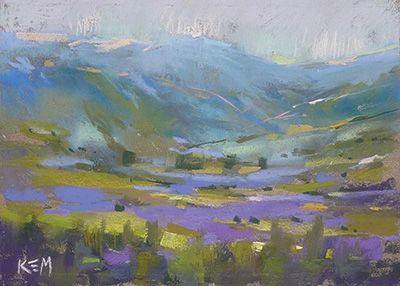
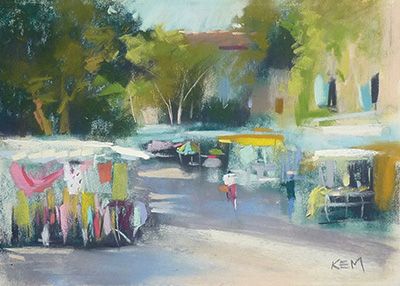
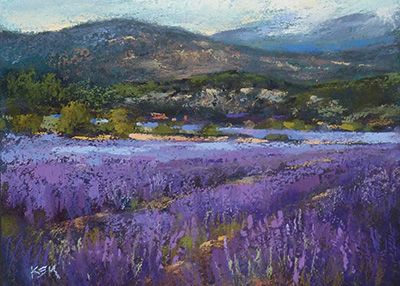
I had no expectations to paint on my trip to Provence. My only goal was to explore the area and take time to smell the lavender. I was delighted that I was able to do that and much more. I feel like I’ve only scratched the surface of exploring my references from this adventure. It’s truly been an example of how travel is a gift that keeps on giving.
Karen Margulis (karenmargulis.com) is an award-winning pastel artist and art educator who teaches painting workshops around the world.










More Stories
Learning Lines with Line Stations
Ep 120 The AHA Moments we Experience as Artists
Wyatt Kahn “Knots & Figures” at Galerie Eva Presenhuber, Vienna